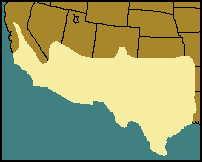|
|
|
|
|
|

Greater Roadrunner
Geococcyx californianus
![]()
Kingdom: Animalia
About 20-24 inches long. Streamlike plumage, dark with white
markings, bushy crest, long, mobile tail, strong legs (Cassidy,
1990). Off-white lower down, with black stripes. A crest of
black feathers on head. Sexes are similar (Bologna, 1978).
Geococcyx californianus is a ground dwelling bird with
short wings. The nest is made in cacti or bushes (Bologna, 1978)
or in low trees or thickets, with nests lined with leaves, grass,
feathers, mesquite pods, snakeskin, and roots (Ehrlich, Dobkin,
and Wheye, 1988). This species is commonly found in grasslands,
bushy areas, deserts, and open woodlands (Cassidy, 1990).
Geographic range of the Greater Roadrunner in the USA; its
range continues south into northern Mexico.
The diet of the Greater Roadrunner consists of insects,
lizards, snakes, small rodents, small birds, fruit, and seeds
(Ehrlich et al., 1988).
Females lay 2-8 eggs (Bologna, 1978). The eggs are chalky
with a yellowish coat and are about 39 mm (1.5 in) in length.
Incubation is from 18-20 days and is done by either parent,
though preferably the male, because the nocturnally incubating
males maintain normal body temperature, whereas the females or
non-breeding males drop their body temperature to as low as 33 C
(91.4 F) to save energy during high temperatures (Ehrlich et
al., 1988). The young are fed by both parents (Cassidy,
1990). The young are able to run and find their own food at 3
weeks (Bologna, 1978).
The Greater Roadrunner is known as the quickest footed
critter in the West. This species is sleek and quick and darts at
speeds of up to 15 miles per hour. It is reputed to fence in
sleeping rattlesnakes with pieces of cactus upon which it stabs
the snake to death with the cactus spines (Cassidy, 1990). When
the Greater Roadrunner is alarmed, it will raise and lower its
crest and tail and/or perform a distraction display to protect
its nest (Ehrlich et al., 1988). The species attracts attention
wherever it goes. It is small wonder that Mexicans call it
paisano, meaning countryman. It is considered a paisano on both
sides of the border (Cassidy, 1990).
American Ornithologists' Union. 1983. Check-list of North
American birds, 6th ed. Allen Press, Lawrence, 877 pp.
Bologna, G. 1978. Simon and Schuster guide to birds of the
world. Simon and Schuster, New York, 511 pp.
Cassidy, J., ed. 1990. Book of North American birds. Reader's
Digest, New York, 576 pp.
Ehrlich, P., D. S. Dobkin, and D. Wheye. 1988. The birder's
handbook. Simon and Schuster, New York, 785 pp.
Lorraine Bueno, July 1995.
Phylum: Chordata
Subphylum: Vertebrata
Class: Aves
Order: Cuculiformes
Family: Cuculidae
Literature Cited
![]()